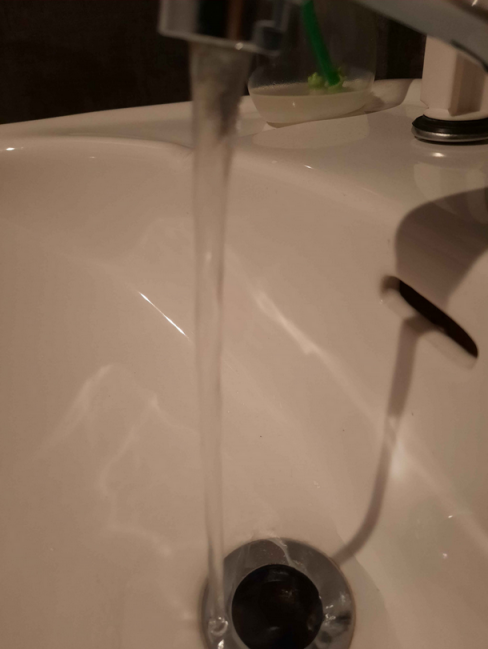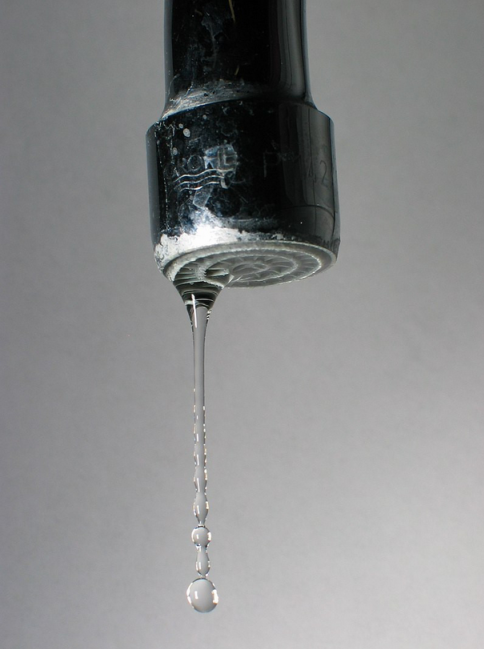A tap water jet's shape
Posted on Mon 18 July 2022 in physics
This is it. The very first physics problem that got me hooked.

In this photo, we can see that the further the water goes down from the tap, the smaller the diameter of the jet will get. (I think, it's actually best visible with the shadow.)
As a child, I really wanted to know what was going on here. So, let's start with a sketch.
We will assume the jet's cross section to be a perfect circle and therefore, use its radius $r$ for calculations instead of its diameter. The cross-section right at the tap will be indicated with a $0$. So, the radius there will be $r_0$, the cross-section area will be $A_0=\pi r_0^2$, and the water's velocity when leaving the tap will be $v_0$. (We will see why we need the velocity, later.)
The depth of the water below the tap will be called $h$. (Thus, going upwards from the tap makes $h$ negative.)
Now, how can we find a relation between $h$ and $r$?
Well, for a start, we can calculate the actual cross-section areas, which are just the areas of circles:
$$ \begin{align} A =& \pi r^2\\ A_0 =& \pi r_0^2\\ \end{align} $$
Conservation of the volumetric flow rate
The key insight is, that in a certain time interval $\Delta t$, a certain amount of water $\Delta V$ emerges from the tap, which is constant.
What's more, the same amount of water has to pass any "plane" of a given lower altitude. If that were not the case, the water would have to be compressed to shorten the time or to be rarefacted to stretch the time, yet there is nothing there that would change the water's density.
In other words, if there is a given amount of water emerging from the tap in a given time that is constant, the same amount has to hit the sink within that same time.
Now, if we choose the time interval to be really small, the ejected water will form a very small cylindrical disc. Its height can be denoted as $\Delta h$. So, we get this:
In the limit of an infinitely small time interval, the quantity
$$\lim_{\Delta t \to 0} {\frac{\Delta V}{\Delta t}} = \frac{dV}{dt}$$
will be constant. This limit is known as the volumetric flow rate. So,
$$ \begin{align} \lim_{\Delta t \to 0} {\frac{\Delta V_0}{\Delta t}} =& \lim_{\Delta t \to 0} {\frac{\Delta V}{\Delta t}}\\ \lim_{\Delta t \to 0} {\frac{A_0 \Delta h_0}{\Delta t}} =& \lim_{\Delta t \to 0} {\frac{A \Delta h}{\Delta t}}.\\ \end{align} $$
Now, the cross-section areas do not depend on time. So, we get:
$$ A_0 \lim_{\Delta t \to 0} {\frac{\Delta h_0}{\Delta t}} = A \lim_{\Delta t \to 0} {\frac{\Delta h}{\Delta t}} $$
As our time interval $\Delta t \to 0$, the water's velocity $v$ and $v_0$ can be considered constant. Thus,
$$ \begin{align} \Delta h =& v \Delta t\\ \Delta h_0 =& v_0 \Delta t.\\ \end{align} $$
We can insert this now. (Down the line, we can also insert the definition of the cross-section areas in terms of their radii.)
$$ \begin{align} A_0 \lim_{\Delta t \to 0} {\frac{\Delta h_0}{\Delta t}} =& A \lim_{\Delta t \to 0} {\frac{\Delta h}{\Delta t}}\\ A_0 \lim_{\Delta t \to 0} {\frac{v_0 \Delta t}{\Delta t}} =& A \lim_{\Delta t \to 0} {\frac{v \Delta t}{\Delta t}}\\ A_0 v_0 \lim_{\Delta t \to 0} {\frac{\Delta t}{\Delta t}} =& A v \lim_{\Delta t \to 0} {\frac{\Delta t}{\Delta t}}\\ A_0 v_0 =& A v\\ A_0 v_0 =& A v\\ \pi r_0^2 v_0 =& \pi r^2 v\\ r^2 =& \frac{r_0^2 v_0}{v}\\ r =& \frac{r_0}{\sqrt{v/v_0}}\\ \end{align} $$
Now, we are almost there, because there is a very easy way to express the velocity $v$ in terms of the altitude $h$.
Conservation of energy
To get to the finish line, we can use the famous conservation of energy. (In particular, the conserved quantity is the sum of kinetic energy $E_{kin}$ and potential energy $E_{pot}$.)
For something of finite mass $m$, the kinetic energy would be straightforward
$$E_{kin} = \frac 12 m v^2.$$
However, in this case, we deal with infinitely tiny amounts $dm$ of water, which gives us an infinitely tiny amount of energy. (Remember, the amount $dm = \rho dV$ is constant in our setting.) Therefore,
$$ \begin{align} d E_{kin} =& \frac 12 v^2 \, dm\\ d E_{kin,0} =& \frac 12 v_0^2 \, dm\\ \end{align} $$
As for the potential energy, we can always add a constant to it. So we set it to zero at the tap:
$$E_{pot,0} = 0$$
With this choice,
$$E_{pot} = -gh \, dm,$$
where $g$ is earth's gravitational acceleration, which we can, once again, consider to be constant. The minus sign is due to the fact, that $h$ increases when we go down, which will get us to a state of lower potential energy.
This implies:
$$ \begin{align} d E_{kin,0} =& d E_{kin} + d E_{pot}\\ \frac 12 v_0^2 \, dm =& \frac 12 v^2 \, dm -gh \, dm\\ v_0^2 =& v^2 -2gh\\ v^2 =& 2gh + v_0^2\\ v =& \sqrt{2gh + v_0^2}\\ \end{align} $$
Now, recall
$$r = \frac{r_0}{\sqrt{v/v_0}}$$
and insert:
$$ \begin{align} r &= \frac{r_0}{\sqrt{v/v_0}}\\ r &= \frac{r_0}{\sqrt{\frac{\sqrt{2gh + v_0^2}}{v_0}}}\\ r &= \frac{r_0}{\sqrt{\sqrt{\frac{2g}{v_0^2}h + 1}}}\\ \end{align} $$
Combining the square-roots, we finally arrive at our answer:
$$ \boxed{r = \frac{r_0}{\sqrt[4]{\frac{2g}{v_0^2}h + 1}}} $$
Notice, that the whole $\frac{2g}{v_0^2}$-term is constant, if the water velocity on exiting the tap is.
In fact, we could define
$$ \begin{align} \lambda &:= \frac{v_0^2}{2g}\\ h^\prime &:= \frac{h}{\lambda}\\ r^\prime &:= \frac{r}{r_0}\\ \end{align} $$
to see, that the general form of the solution is always a scaled or stretched version of this:
$$r^\prime = \frac{1}{\sqrt[4]{h^\prime + 1}}$$
This will allow for some easy consistency checks.
Consistency and limits of our solution
Scaling of $r$ and surface tension
As $r= r_0 r^\prime$, a larger $r_0$ will lead to a larger $r$, which makes sense.
However, there is a physical effect, which we have neglected so far. Surface tension.
When $r$ is large, it should be negligible, but when $r$ gets smaller and smaller, it will become a profound effect in so far, as we will no longer see a continuous jet of water but rather individual droplets.
The wikipedia-article on surface tension has a better picture of this than I could ever hope to take with my devices:

Yet, this is nothing I worry too much about, as I only wanted to generally understand the shape of the water jet and what effects lead to it.
Scaling of $h$
This one is a bit more interesting.
Recall,
$$h = \lambda h^\prime = \frac{v_0^2}{2g} h^\prime.$$
So, what happens when we choose a larger $\lambda$?
Well, in order to reach a given cross-section radius, $h$ becomes larger, as well. This means, the water has to fall down further, before the cross-section gets that small.
Since $\lambda$ increases and decreases with the square of the water's emerging velocity $v_0$, the same principle relation holds for the velocity.
This also seems to make sense. If the water exits the tap faster, it takes longer for the cross-section to get smaller. (Of course, you can experimentally verify this, as well.)
Personal wrap up
While this might not be the most intriguing or challenging physical problem, it is my first one. I probably cannot convey how proud I was of myself, when I finally found a solution - years after I first wondered about what was going on with that water.
So, I am especially satisfied to have finished this article and will reward myself with a glass of tap water.

